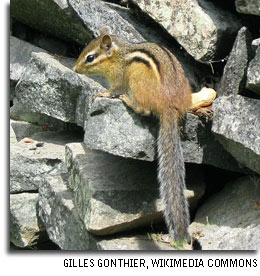Eastern Chipmunk
(Tamias striatus)
 Description and Range:
Description and Range:
The eastern chipmunk is the only chipmunk found in Maryland. Eastern chipmunks have mostly reddish-brown fur with a single black stripe running down the center of their back. Two black stripes and one white stripe runs down each side of their body, from the neck almost to their tail. The eastern chipmunk also has a white underside and a white stripe above and below its eyes. Chipmunks range in size from 8 to 10 inches long (including the tail) and weigh between 2 to 5 ounces. Males and females look identical.
Eastern chipmunks can be found throughout the eastern United States and southeastern Canada. In Maryland, eastern chipmunks can be found west of the Chesapeake, particularly in the western region.
Habitat:
The eastern chipmunk is found in deciduous forests, shrublands, forest edges and suburban and urban areas where there is abundant cover to protect it from predators. Chipmunks build a network of underground burrows that can go up to 30 feet in length and 3 feet in depth. The burrow entrance usually is about 2 inches wide, and chipmunks will remove fresh dirt from the entrance to hide their burrow.

Diet:
Surprisingly, eastern chipmunks are omnivores- consuming both plants and animals. They will eat seeds, nuts, berries, fruits, flowers, mushrooms, worms, snails, small frogs and even bird eggs. While feeding, chipmunks often help to disperse seeds of plants and spores from fungi. While foraging, chipmunks often stuff food in their cheeks which can expand up to 3 times their normal size.
Reproduction:
Chipmunks become sexually mature at 1 year. Chipmunks mate twice a year from February to April and again from June to August. Females gestate for 31 days and then give birth to 2-6 young per litter in an underground burrow. Males do not help with rearing the young. Newborn chipmunks are born hairless, blind and as tiny as a bumblebee. It takes 6 weeks for them to be able to leave the burrow and another 2-4 weeks for them to be independent from their mother.
Behavior:
Chipmunks are most active in the morning and in late afternoon. While they can climb trees, much of their time is spent on the ground foraging. Male and female chipmunks only come together during mating season. Chipmunks are very territorial.
Sound:
Chipmunks make single or repeated bird-like chip calls to signal their presence. For repeated calls, they can make 80 - 180 chips per minute. In addition, they also make chucks which are lower pitched and signal caution, fear or annoyance. When startled, chipmunks will make a trill composed of rapidly repeated chips. When fighting, chipmunks will make a chuck trill. In contrast, they will whistle during mating.